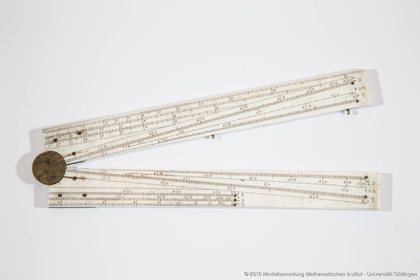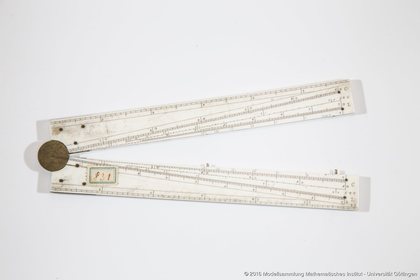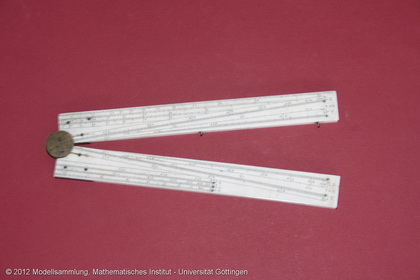4 antique drawing tools
Model 831
Description
One of four antique drawing instruments.
Additions
This model is an English proportional compass made of ivory, also called sector. In principle it is a modern version of the model 830, which is why some scales match. As with 830, more complicated mathematical calculations can be solved geometrically in a relatively simple way.
There are pairs of scales on the front and back of the instrument, which start from the pivot point of the legs, these are called sectorial scales. But also scales which are used when the instrument is completely open are engraved. On the front side there is an inch scale on the outer edge, which can be used as a ruler. The central sectorial scale on the front is the Line of Lines. It is divided into 200 equal parts by increments of $10$ and arithmetic tasks can be performed on the basis of the rays.
There is also a Line of Chordes and POL-Line on the front. Further descriptions are given for model 830.
Another scale is a Line of Secants. It is an angular scale, which is divided from $0^{\circ}$ to $75^{\circ}$. The secant is the reciprocal of the cosine, i.e. it is calculated by the ratio of the hypotenuse to the adjacent cathete. With this scale, one may calculate the actual distance to be covered (hypotenuse) from a given length on a map (cathete) and the corresponding gradient.
The sectorial line pairs on the back of the compass are a sinusoidal and a tangent scale. These angular scales can be used to calculate the opposite catheter to a given hypothenuse (sinus scale) or a given cathete (tangent scale). The tangent scale is divided for angles that are smaller than $45^{\circ}$ and those that are larger.
On the outer rim there are three further scales which are used when the instrument is completely open. There is a logarithmic scale over two orders of magnitude, marked $N$, a logarithmic sine scale $S$ and a logarithmic tangent scale $T$. With the $N$ scale, logarithmic laws allow complicated multiplications to be solved by additions. The $S$ and $T$ scales provide values for angular relationships for further calculation on the $N$ scale.
Showcase of this model is Case number 45




